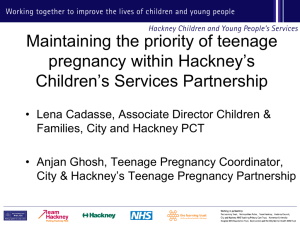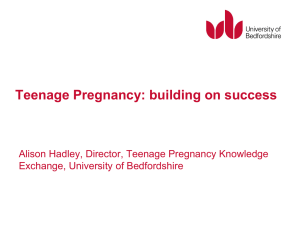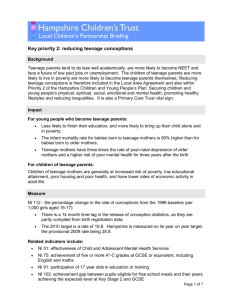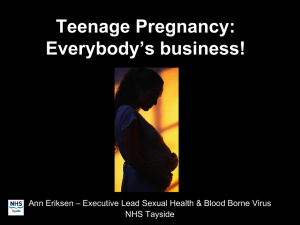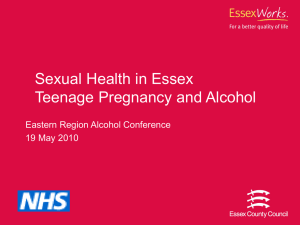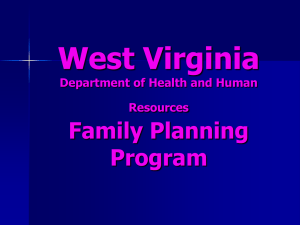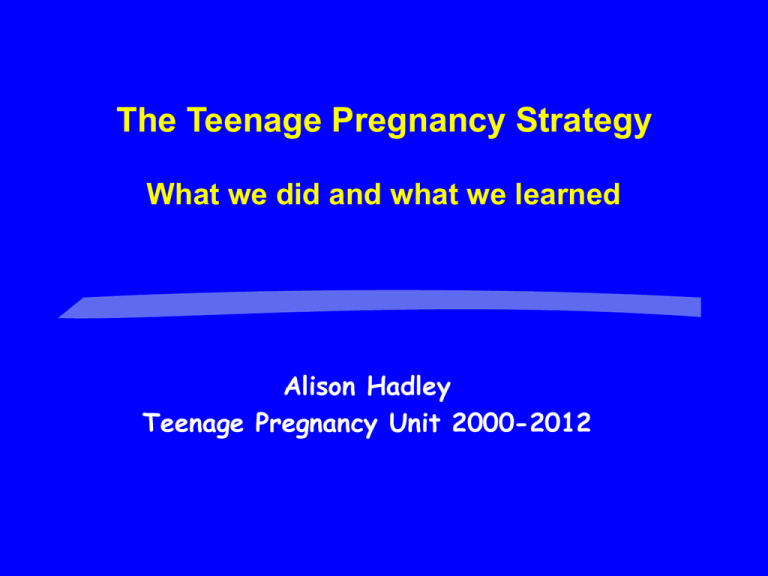
The Teenage Pregnancy Strategy
What we did and what we learned
Alison Hadley
Teenage Pregnancy Unit 2000-2012
The journey of the Strategy
Why a teenage pregnancy strategy?
15% of all young people not in
education , training or employments
are teenage mothers or pregnant
teenagers
20% more likely to have no
qualifications at age 30
22% more likely to be living in
poverty at 30, and much less likely
to be employed or living with a
partner
Children of teenage mothers have a
63% increased risk of being born
into poverty and are more likely to
have accidents and behavioural
problems
The infant mortality rate for babies
born to teenage mothers is 60%
higher
3 times more likely to smoke
throughout their pregnancy, and
50% less likely to breastfeed, with
negative health consequences for
the child
3 times the rate of post-natal
depression and a higher risk of poor
mental health for 3 years after the
▪
birth
England’s teenage pregnancy rate
was significantly higher than
comparable European countries
and had remained static since
1980s
The start of the Strategy
Social Exclusion Unit Teenage Pregnancy Report
published 1999
International review of evidence
National target set of 50% reduction in under 18
conception rate by 2010
Supporting teenage parents into education and
training
30 point action plan for 10 year strategy
The four themes of the Strategy
Joined up action
Better prevention: improving sex and
relationships education and access to
contraception
National campaign to reach young people and
parents
Better support for teenage parents
Joined Up Action
Establishing clear goals
National and local targets
National target:
- 50% reduction in under 18 conception rate by 2010
- Interim target of 15% reduction by 2004
Local targets for every Local Authority area:
- 60% reduction in high rate areas
- 50% reduction in average rate areas
- 40% reduction in low rate areas
Achievement of all local targets = 50% national
reduction
Joined Up Action
The Structures
Joined up action: nationally
Teenage Pregnancy Unit
- cross departmental funding
- combined skills of external experts and civil servants
Inter-departmental Teenage Pregnancy Board
Teenage Pregnancy Independent Advisory Group
- monitor implementation of Strategy and advise Ministers
- external experts on young people, contraception/sexual
health, sex and relationships education, parenting,
housing, local government and research
Joined up action: regionally and locally
Regional Government Offices (9)
Regional Teenage Pregnancy Coordinators
- leading cross-cutting panels to link teenage pregnancy
with relevant health, education, youth services, parenting
support programmes
Local Authority (150)
Local Teenage Pregnancy Coordinator
Local Teenage Pregnancy Partnership Boards
- with representation from health, education, housing, social
services, youth services and relevant NGOs
Joined Up Action
Funding
Funding
Local Implementation Grant for every local area: £25M
per year
Size of grant: determined by size of population and
degree of challenge (150K-600K per annum)
Ring fenced with conditions for spend:
- appointment of local Teenage Pregnancy Coordinator
- Teenage Pregnancy Partnership Board
- Annual report on local progress
Central government funding to support national
campaign and other strategy activity: £7M
Developing local teenage pregnancy strategies
National guidance on developing local strategies
Local strategy developed by Teenage Pregnancy
Partnership Board
Each strategy assessed by Regional Teenage
Pregnancy Coordinator and Teenage Pregnancy Unit
Annual report on progress submitted by each
Partnership Board and assessed by RTPCs and TPU
National activity to support local strategies
Maintaining the priority across Government:
- Teenage pregnancy target included in joint Public
Service Agreement between education
- Target included in relevant health, education and
social care programmes
Leadership and communications:
- Quarterly meetings with Regional TPCs to support
policy delivery and understand and address
challenges
- Annual conferences for Local TPCs
Providing national guidance and frameworks
National activity to support local strategies:
improving sex and relationships education
New Government guidance for schools on Sex and
Relationships Education – statutory requirement for
schools to pay regard to guidance
Non-statutory framework for Personal Social and
Health Education (PSHE)
Professional development programme for teachers to
improve skills on SRE and Personal Social and
Health Education – with funding for participation
Funding support for the Sex Education Forum to
promote evidence based briefings and practical
advice to schools and local areas
National activity to support local strategies:
improving access to contraception
Guidance on young people friendly contraceptive
services
Guidance for youth workers and social workers to
support young people to use contraceptive services
Guidance on increasing contraception and condom
use by boys and young men
Guidance on reaching young people from black and
minority ethnic communities
Guidance on establishing contraception and sexual
health services in schools and colleges
Quality criteria for young people friendly services
Accessibility: in the right place, open at the right time
Publicity
Confidentiality and consent
Youth friendly service environment
Staff training, skills, attitudes and values
Joined up working with other young people’s services
Monitoring, evaluation and involvement of young
people – ‘mystery shopping’ of services
National activity to support local strategies:
National Campaign
Universal campaign for under 18s (boys and girls)
Sex. Are you thinking about it enough?:
Headline messages:
- Resisting peer pressure
- Awareness of risk of pregnancy and STIs
- Condom use
- National radio and magazine adverts
- Leaflets and posters for local use
- Supported by website and free national helpline
National activity to support local strategies:
National Campaign
Parents campaign: Time to Talk
Headline messages:
- Parents talking their children about sex and
relationships helps prevent teenage pregnancy
- Practical tips on having conversations
- Up to date information about contraception and sexual
health
Leaflets and posters for local areas
Supported by NGO parenting support free helpline
and fpa Speakeasy
Mid-strategy review
Mid-strategy review: confirmation of the evidence
Vast majority of teenage pregnancies are unplanned
Provision of high quality SRE (Kirby 2007) and
improved use of contraception (Santelli 2008) are
areas where strongest empirical evidence exists on
impact on teenage pregnancy rates
No evidence that alternative approaches (e.g
abstinence-only/benefit conditionality) are effective
Mid-Strategy Review 2005-07
Steady decline in national rate but wide variation in
progress between local areas
Prime Minister Delivery Unit review comparing similar
areas showing different rates of progress
- progress determined by action not funding
- high rates not inevitable even in deprived areas
Further analysis of data: high rate wards,
characteristics of young people most at risk, 80% of
conceptions to 16-17s, repeat conceptions...
Review of campaign → new ruthinking for under 16s,
Want Respect Use a Condom for 16+
New guidance and Ministerial focus
More prescriptive guidance for local areas
Self assessment toolkit to help local areas monitor
their actions
New Ministerial focus on areas with high and
increasing rates:
- annual meetings with senior leaders
- six monthly progress reports with ministerial
feedback to Chief Execs and Elected Members
Additional support from Regional Teenage
Pregnancy Coordinators and Department of Health
National Support Team
New more prescriptive guidance: the ten key factors for
effective delivery
SRE in schools
and colleges
Supporting
parents
to discuss sex &
relationships
Dedicated support
for teenage
parents –
including SRE
and contraception
Young people
friendly
contraceptive &
SH services
Clear and
consistent
messages
to young people,
parents and
practitioners
Strategic
leadership
&
accountability
Strong use
of data for
commissioning &
Local
performance
management
Workforce training
on SRE
Targeted SRE
and
contraception/SH
support for young
people at risk
SRE & access to
contraception in
youth services
Good local delivery brings down rates:
The 10 key characteristics of successful programmes
Strategic: senior champions within council and PCT, engagement from
all partner agencies and accountability to Partnership Board
Data: local data and population knowledge used to inform
commissioning of services and to monitor progress
Strong delivery of sex and relationships education (SRE) within PSHE
by all schools
Support for parents and carers to encourage early discussion on sex
and relationships with their children
Young people focused contraception/sexual health services, trusted
by teenagers and well known by professionals working with them –
86% of decline in US rates due to improved contraceptive use
Good local delivery brings down rates:
The 10 key characteristics of successful programmes
Targeted SRE and sexual health advice for at risk groups of young
people: e.g. Young people with low education attainment, not in
training or employment, Children in Government care, young people in
homeless units and supported housing, teenage parents
Workforce training on sex and relationships for practitioners working
with young people – e.g. Youth workers, social workers
Well resourced statutory and voluntary sector youth service tackling
teenage pregnancy and other social and health issues
Communications: clear and consistent messages to young people and
parents, internal stakeholders and the local media
Dedicated coordinated support for teenage parents including SRE and
contraception to reduce repeat pregnancies
Additional focus on improving awareness and use of
effective contraception
Additional Department of Health funding to expand
access to contraception and Long Acting Reversible
Contraceptive methods
Review of national campaign and key role of
communications identified:
- normalising conversations about contraception and
sexual health between young people, with parents
and with professionals
- raising awareness of effective contraception
Approaching 2010...
Strong and visible partnership between Departments
of Health and Education Ministers
High rate areas under Ministerial focus start to see
rates decline
First TV advertising of contraception – with no
complaints!
Big expansion in access to contraception and LARC
Broad consensus between young people and parents
on age of first sex, sex and relationships education
and access to contraception
Broad consensus among young people and parents
Age of first sex
Young people and parents agree on right sort of age for
first sex – 16.5-17 years
Sex and relationships education (SRE)
Young people (96%) and parents (86%) support school
SRE
86% of parents believe there would be fewer teenage
pregnancies if parents talked more to their children about
sex and relationships
Access to contraception
75% of parents agree young people, including under 16s,
should have access to confidential contraceptive services
and the final 2010 data...
25% reduction in under 18 conception rate:
46.2 per 1000 15-17s → 35.4 per 1000 15-17s
35% reduction in conceptions leading to birth
Lowest rate since 1969 – over 40 years
60,000 conceptions saved – if conception rate had
stayed the same as 1998
Lessons learned
A clear goal is vital but targets needs to be realistic
Concerted effort makes a difference – high teenage
pregnancy rates are not inevitable
We know what works and how to translate evidence into
local actions
Senior leadership and partnership work is vital – at
national and local level
Building and highlighting consensus is key

